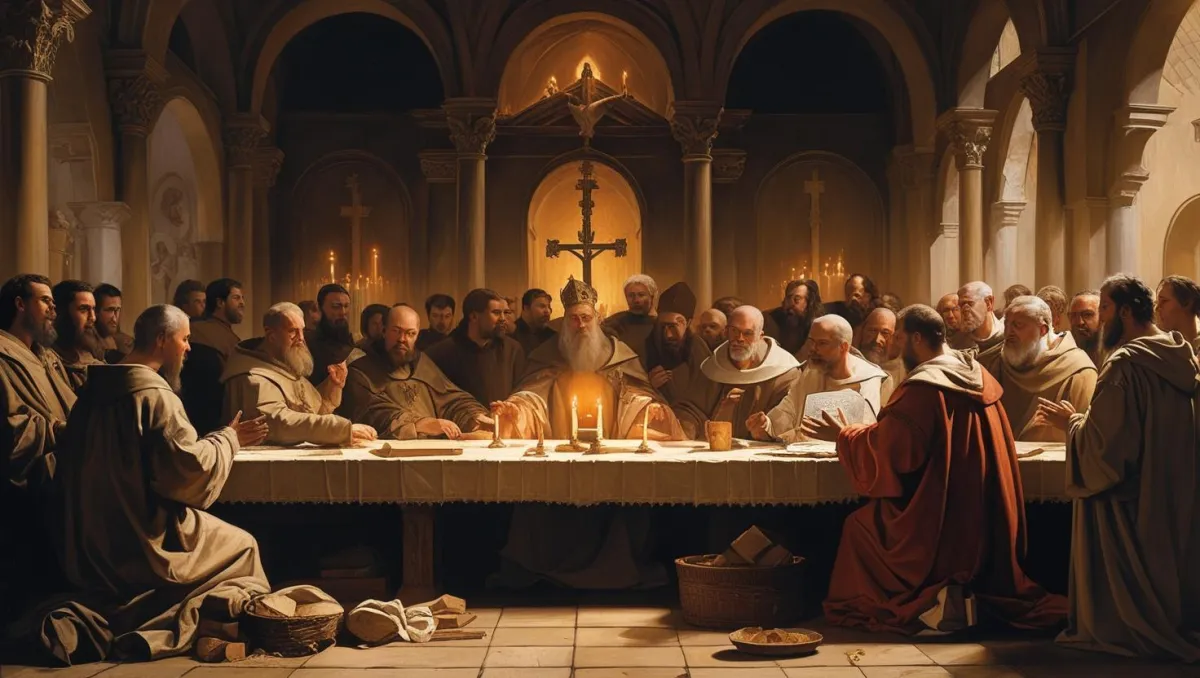WELCOME!
Thank you for contributing to biblical research!
Dive into a world of captivating narratives that transport you to a deeper understanding of the Lord, Jesus Christ. Learning about Christ involves biblical, theological, and practical research; these are essential areas for believers to study to grow in spiritual maturity.

The Great Schism, and the Redemptive Solution
Have you ever divided a Christian over spiritual gifts? Have you ever divided over Calvinism versus Arminianism? Have you ever divided a believer over a colored tapestry in your church? All these are essential questions to ponder, especially regarding Christian unity after the Council of Chalcedon, which ecumenically established Christ as God and Man. Core doctrine pervades the land. This was crucial in developing many other issues that arose in the Middle Ages. Many problems came after this, eventually leading to the Great Schism (1054 A.D). According to history, Christians can unite by learning from the Great Schism, including its seeds, division, and application.
The first point is that, according to history, Christians can unite by learning from the Great Schism. How did this all begin? According to observations by Mark Noll, these two religious schools of churches fall into the distinctive character traits of Tertullian and Clement.[1] For example, Tertullian was a Roman (Latin) lawyer. Clement was Greek and a philosopher.[2] This is important as it relates to cultural engagement. Furthermore, the discussion of the beginning of filioque was born (Holy Spirit from the Father, or Son).[3] Also, the supreme authority of the pope. These seeds began the Great Schism; the following field covers the event.
The second point is that, according to history, Christians can achieve unity by learning from the Great Schism, which was a period of division. One notable observation is that while these circumstances were brewing, Robert Walton describes historically that Monasticism was proliferating in the church. Popes needed to be more authoritative in their political puppetry of international powers.[4] Apart from conversations about icons in the church, the Photian Schism had a significant impact on the church, ultimately leading to the Great Schism.[5] Furthermore, distinct congregations are divided. What is fascinating is that the Crusades impacted this circumstance. The Fourth Crusade involved quite an exciting feat; Sharon and Michael Rusten provide this circumstance: "A compromise was reached wherein the campaigners agreed to attack Constantinople, the capital of Eastern Christendom, in exchange for passage to Jerusalem.”[6" So, as described, it went to the heart of the churches. These represent the historical phenomenon of the Great Schism. Lastly, the last area covers lessons learned.
The third point is that, according to history, Christians can achieve unity by learning from the Great Schism through practical application. It is important to note that these issues are secondary, not core doctrines. Icons, Bible interpretations, and backbiting are essential in terms of friendship: necessary to work out, but not so much as to cause a significant divide. The Apostle James writes about slandering and judging others (Jas. 4:11-12). The first considerable application to contend with is not to destroy other Christians despite their beliefs. Icons, authority, monastics, and philosophy are essential but not core doctrines to separate a believer over. Yes, this also implies theological systems. My mother told me not to major in the minors. How true is it one thousand years ago, compared to now? The second application is to have unity with believers. In the Fourth Crusade, the church could have consulted the eastern church covertly and instead attacked the heart of one group of believers. The third application is to consider where this all stands in relation to Jesus Christ. Christians are all but children in the eyes of Christ. Believers should have a good relationship with each other, as Christ died for this blessing of unison (Eph. 3:13-16). These are critical points to take away from this study.
Before this circumstance, monastic reforms were underway during this time.[7] This event also led to the emergence of popes and anti-popes during the East-West Schism.[8] It is fascinating to note that the Eastern church began at this moment. However, it started with the formation of the school of Alexandria.[9] This is a crucial factor, as since the founding of this area (later compared with those in Constantinople and Antiochene thought), many adapted towards a philosophical lifestyle.[10] Luckily, the Council of Constantinople ended this massive Schism. Joshua Hollmann writes that the results of this elder meeting, essential decrees of the Council of Constance, featured ecclesial reform and initiated the conciliar movement that attempted to limit the power of the papacy and provoked a period of conflict between councils and the pope.”[1" ] What is fascinating about this council, in particular, is that in writing, it also fixed the rule allowing Papal Supremacy the Pope's reverence above Christ) to every believer obeying Jesus Christ as the ultimate authority.[12] These are essential after-effects of the Great Schism.
The Great Schism also relates to the Fall of Constantinople. Many factors contributed to this Great Schism, including political, spiritual, and motivational upheaval. Noll provides fascinating insight revolving around this circumstance filled with hope centuries after the event, “Th" Eastern emperor and the Eastern patriarch both journeyed to another reunion council…After intense debate for several months in 1438–39, all but one member of the large Eastern delegation agreed to a formula to heal the schism.”[1" ] The emperor was so set on this circumstance (DB thread) has written, the emperor was so set on this circumstance that he died with him.[14] This is after the Council of Constance (1414-1418). While other students in this thread identified the motivation as the cause of this Schism, it is crucial to understand that the situation's longevity, the underlying issue remains unresolved. The Lord allowed opportunities for a solution to this great conflict. Blessed are the peacemakers, for they are the sons of God (Matt. 5:9). Paul, in his overabundance of the Jewish believers in Italy, encourages them to strive in peace and holiness, allowing not roots of bitterness to sprout, by it many become defiled (Heb. 12:14-15). These are essential words to live by to avoid significant conflicts, such as the Great Schism.
In conclusion, according to history, Christians can achieve unity by learning from the Great Schism, including its seeds, division, and application. So right now, you are reflecting on American Christianity, how the schisms, breakups, divides, and opinions scatter the physical body of Christ. Will you choose to unite with a fellow believer, valuing secondary issues?
Bibliography
Joshua Hollmann, “Constance, Council of,” ed. Michael A. G. Haykin. The Essential Lexham Dictionary of Church History. Bellingham, WA: Lexham Press, 2022.
Jackson, Samuel Macauley, ed. The New Schaff-Herzog Encyclopedia of Religious Knowledge: Embracing Biblical, Historical, Doctrinal, and Practical Theology and Biblical, Theological, and Ecclesiastical Biography from the Earliest Times to the Present. New York; London: Funk & Wagnalls, 1908–1914.
Noll, Mark A. Turning Points: Decisive Moments in the History of Christianity. Third Edition. Grand Rapids, MI: Baker Academic, 2012.
Rusten, Sharo,n with E. Michael. The Complete Book of When & Where in the Bible and throughout History. Wheaton, IL: Michael E Rusten, 2005.
Walton, Robert C. Chronological and Background Charts of Church History. Revised Edition. ZondervanCharts. Zondervan, 2018.
[1] Mark A. Noll, Turning Points: Decisive Moments in the History of Christianity, Third Edition. (Grand Rapids, MI: Baker Academic, 2012), 126–127.
[2] Ibid.
[3] Ibid, 128.
[4] Robert C. Walton, Chronological and Background Charts of Church History, Revised Edition. Zondervan Charts (Zondervan, 2018), 34.
[5] Mark A. Noll, Turning Points: Decisive Moments in the History of Christianity, Third Edition. (Grand Rapids, MI: Baker Academic, 2012), 130.
[6] Sharon Rusten with E. Michael, The Complete Book of When & Where in the Bible and throughout History (Wheaton, IL: Michael E Rusten, 2005), 180.
[7] Mark A. Noll, Turning Points: Decisive Moments in the History of Christianity, Third Edition. (Grand Rapids, MI: Baker Academic, 2012), 122.
[8] Samuel Macauley Jackson, ed., The New Schaff-Herzog Encyclopedia of Religious Knowledge: Embracing Biblical, Historical, Doctrinal, and Practical Theology and Biblical, Theological, and Ecclesiastical Biography from the Earliest Times to the Present Day (New York; London: Funk & Wagnalls, 1908–1914), 238.
[9] Ibid., 124.
[10] Ibid.
[11] Joshua Hollmann, “Constance, Council of,” ed. Michael A. G. Haykin, The Essential Lexham Dictionary of Church History (Bellingham, WA: Lexham Press, 2022).
[12] Ibid.
[13] Mark A. Noll, Turning Points: Decisive Moments in the History of Christianity, Third Edition. (Grand Rapids, MI: Baker Academic, 2012), 125.
[14] Ibid.

